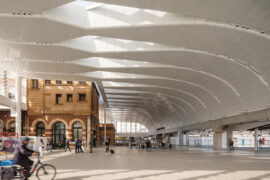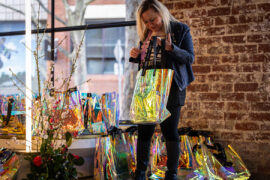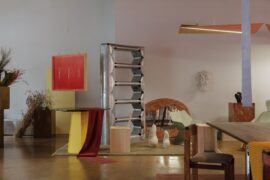Featuring Ross Gardam, Holly Ryan and speakers from Arnsdorf and Sussex Taps, the VAMFF panel discussion explored environmental best practice across industrial design, handcrafted jewellery, and fashion.

(L-R) Gemma Cahill (Arnsdorf), Ross Gardam, Holly Ryan, Vanessa Katsanevakis (Sussex Taps) and Jes Blanch (moderator from Russh magazine).
March 21st, 2018
What do makers mean when they refer to their work as ‘sustainably made’? How can the industries of design and fashion, and we the consumers, do better by the planet?
These questions formed the root of a thought-provoking conversation between industrial designer Ross Gardam, bespoke jeweller Holly Ryan, Gemma Cahill, production manager at local label Arnsdorf and Vanessa Katsanevakis of Sussex Taps. Moderated by Jess Blanch, editor in chief of Russh Magazine, the VAMFF event attracted style enthusiasts and curious environmentalists alike.
Many in attendance were curious to hear of Arnsdorf’s journey. The apparel brand founded by Melbourne fashion designer Jade Sarita Arnott in 2006 closed its doors in 2012, and was revived late last year. Having worked with Jade for a year and a half, sustainability panellist Gemma joined the brand in its second iteration and was employed to sew the first collection of new samples.
“At Arnsdorf we have a very multifaceted approach to sustainability, it encompasses a wide variety of avenues that we take,” explained Gemma. “Our number one is to have our own factory. Instead of outsourcing, we employed a few really talented women to sew our clothes in-house, all in Collingwood. Our workroom is there, we photograph and tag certain products there, and everything that you see that is Arnsdorf happens from that one little building.”
During the conversation, Bronte-based jeweller Holly Ryan revealed her latest improvement on environmental processes for her business.
“I really care about sustainable production,” said Holly. “This new recycling initiative that I have, called Old for New, is an invitation to my customers to get involved in the recycling process that we already use within our studios.”
Under this arrangement, people who have bought jewellery from Holly Ryan Studio and, for reasons of style, are no longer as enamoured by it – are invited to return it in exchange for a store credit. The customer can then purchase from current collections, while the studio is able to reuse the metal, reducing their impact on landfill.
“Basically anything with my name on it, that I’ve made, I feel responsible for. And I’d like to encourage the consumers buying my jewellery to feel responsible for it as well,” said Holly.
Vanessa Katsanevakis shared her own recollections on metal recycling, of her father, Sussex Taps’ founder Nicolaas Johannes van Putten, who was a watchmaker prior to starting the family business.
“Having the same origins, in jewellery, I remember my father having a little furnace to melt down metals for repurposing. And the tap business has continued that vertical integration; that closed-loop system,” Vanessa said. “We’re able to re-melt all our brass shavings that are the by-product of our manufacturing, into new brass bars. It’s not sold off as scrap, it’s something that we can control the process of that we find really valuable.”
Industrial designer, Ross Gardam, brought his own insight to the panel.
“We do have a product stewardship policy, where we will take products back and repurpose it, and that’s in partnership with our distributor,” Ross said. “From a design perspective, sustainability is intertwined in what we do in our initial process. Some of our products have a certification at the end, which means that we are really restricted right up at the front of the design process with what materials we can use.”
His support of trades and craftspeople was a particular highlight, as Ross explained:
“We don’t make all of what we do in-house, but we do work with local makers, ceramicists, glass-blowers, wood turners, to create components for our products, and these are worked over by our studio.”

















Take a read of our catch up with Ross Gardam.
INDESIGN is on instagram
Follow @indesignlive
A searchable and comprehensive guide for specifying leading products and their suppliers
Keep up to date with the latest and greatest from our industry BFF's!

London-based design duo Raw Edges have joined forces with Established & Sons and Tongue & Groove to introduce Wall to Wall – a hand-stained, “living collection” that transforms parquet flooring into a canvas of colour, pattern, and possibility.
The new range features slabs with warm, earthy palettes that lend a sense of organic luxury to every space.

Now in their 19th year, the Architecture & Design Sustainability Awards are Australia’s leading program dedicated to recognising innovation and excellence in sustainable architecture and design.
The internet never sleeps! Here's the stuff you might have missed

As the next event in a series of discussions centring on Richard Francis-Jones’ book comes to Brisbane, we hear directly from the speakers on fences, villas and the importance of critical community.

Explore the prizes up for grabs at Saturday Indesign this year when you register and check into 10+ showrooms on the day.

The inaugural Adelaide Design Week *everywhere unfolded across five days and nights, bringing together the creative community in a way that hadn’t happened before. Organiser and regular contributor Bronwyn Marshall gives us the inside story.

London-based design duo Raw Edges have joined forces with Established & Sons and Tongue & Groove to introduce Wall to Wall – a hand-stained, “living collection” that transforms parquet flooring into a canvas of colour, pattern, and possibility.